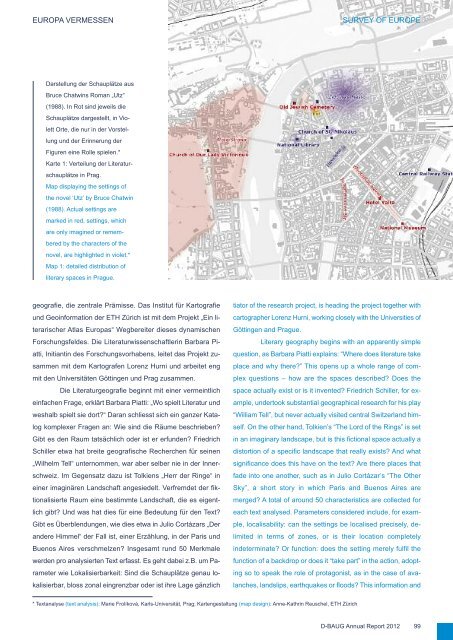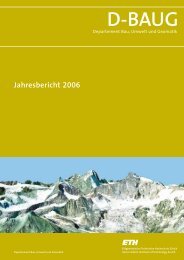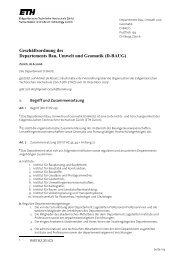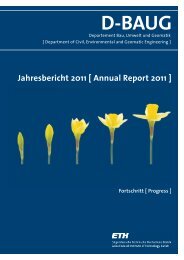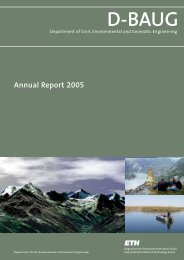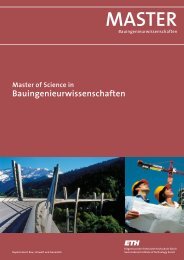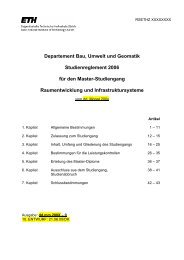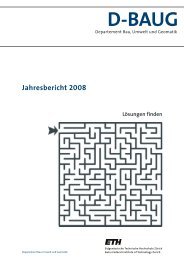Annual Report 2012 - Departement Bau, Umwelt und Geomatik ...
Annual Report 2012 - Departement Bau, Umwelt und Geomatik ...
Annual Report 2012 - Departement Bau, Umwelt und Geomatik ...
- Keine Tags gefunden...
Sie wollen auch ein ePaper? Erhöhen Sie die Reichweite Ihrer Titel.
YUMPU macht aus Druck-PDFs automatisch weboptimierte ePaper, die Google liebt.
EUROPA VERMESSEN<br />
SURVEY OF EUROPE<br />
Darstellung der Schauplätze aus<br />
Bruce Chatwins Roman „Utz“<br />
(1988). In Rot sind jeweils die<br />
Schauplätze dargestellt, in Violett<br />
Orte, die nur in der Vorstellung<br />
<strong>und</strong> der Erinnerung der<br />
Figuren eine Rolle spielen.*<br />
Karte 1: Verteilung der Literaturschauplätze<br />
in Prag.<br />
Map displaying the settings of<br />
the novel ‘Utz’ by Bruce Chatwin<br />
(1988). Actual settings are<br />
marked in red, settings, which<br />
are only imagined or remembered<br />
by the characters of the<br />
novel, are highlighted in violet.*<br />
Map 1: detailed distribution of<br />
literary spaces in Prague.<br />
geografie, die zentrale Prämisse. Das Institut für Kartografie<br />
<strong>und</strong> Geoinformation der ETH Zürich ist mit dem Projekt „Ein literarischer<br />
Atlas Europas“ Wegbereiter dieses dynamischen<br />
Forschungsfeldes. Die Literaturwissenschaftlerin Barbara Piatti,<br />
Initiantin des Forschungsvorhabens, leitet das Projekt zusammen<br />
mit dem Kartografen Lorenz Hurni <strong>und</strong> arbeitet eng<br />
mit den Universitäten Göttingen <strong>und</strong> Prag zusammen.<br />
Die Literaturgeografie beginnt mit einer vermeintlich<br />
einfachen Frage, erklärt Barbara Piatti: „Wo spielt Literatur <strong>und</strong><br />
weshalb spielt sie dort“ Daran schliesst sich ein ganzer Katalog<br />
komplexer Fragen an: Wie sind die Räume beschrieben<br />
Gibt es den Raum tatsächlich oder ist er erf<strong>und</strong>en Friedrich<br />
Schiller etwa hat breite geografische Recherchen für seinen<br />
„Wilhelm Tell“ unternommen, war aber selber nie in der Innerschweiz.<br />
Im Gegensatz dazu ist Tolkiens „Herr der Ringe“ in<br />
einer imaginären Landschaft angesiedelt. Verfremdet der fiktionalisierte<br />
Raum eine bestimmte Landschaft, die es eigentlich<br />
gibt Und was hat dies für eine Bedeutung für den Text<br />
Gibt es Überblendungen, wie dies etwa in Julio Cortázars „Der<br />
andere Himmel“ der Fall ist, einer Erzählung, in der Paris <strong>und</strong><br />
Buenos Aires verschmelzen Insgesamt r<strong>und</strong> 50 Merkmale<br />
werden pro analysierten Text erfasst. Es geht dabei z.B. um Parameter<br />
wie Lokalisierbarkeit: Sind die Schauplätze genau lokalisierbar,<br />
bloss zonal eingrenzbar oder ist ihre Lage gänzlich<br />
tiator of the research project, is heading the project together with<br />
cartographer Lorenz Hurni, working closely with the Universities of<br />
Göttingen and Prague.<br />
Literary geography begins with an apparently simple<br />
question, as Barbara Piatti explains: “Where does literature take<br />
place and why there” This opens up a whole range of complex<br />
questions – how are the spaces described Does the<br />
space actually exist or is it invented Friedrich Schiller, for example,<br />
<strong>und</strong>ertook substantial geographical research for his play<br />
“William Tell”, but never actually visited central Switzerland himself.<br />
On the other hand, Tolkien’s “The Lord of the Rings” is set<br />
in an imaginary landscape, but is this fictional space actually a<br />
distortion of a specific landscape that really exists And what<br />
significance does this have on the text Are there places that<br />
fade into one another, such as in Julio Cortázar’s “The Other<br />
Sky”, a short story in which Paris and Buenos Aires are<br />
merged A total of aro<strong>und</strong> 50 characteristics are collected for<br />
each text analysed. Parameters considered include, for example,<br />
localisability: can the settings be localised precisely, delimited<br />
in terms of zones, or is their location completely<br />
indeterminate Or function: does the setting merely fulfil the<br />
function of a backdrop or does it “take part” in the action, adopting<br />
so to speak the role of protagonist, as in the case of avalanches,<br />
landslips, earthquakes or floods This information and<br />
* Textanalyse (text analysis): Marie Frolíková, Karls-Universität, Prag; Kartengestaltung (map design): Anne-Kathrin Reuschel, ETH Zürich<br />
D-BAUG <strong>Annual</strong> <strong>Report</strong> <strong>2012</strong><br />
99


